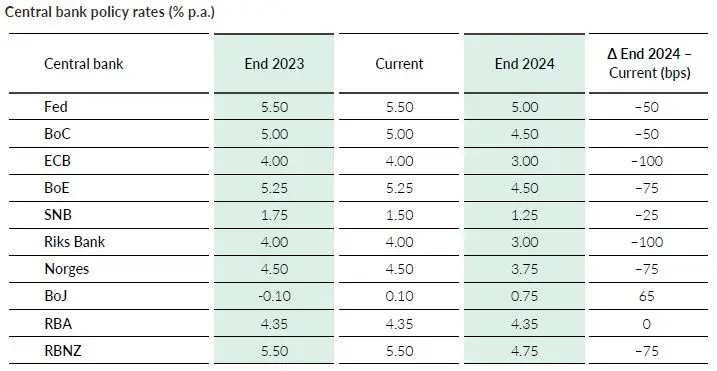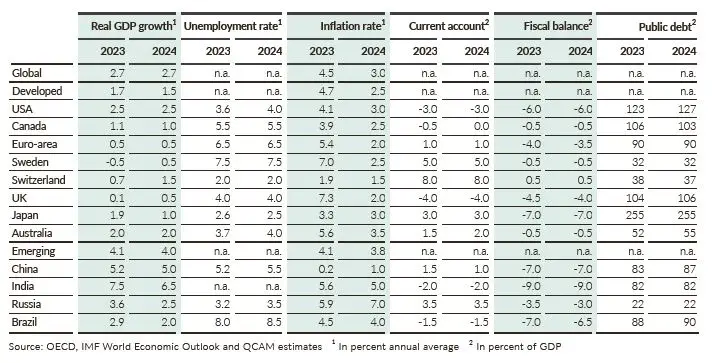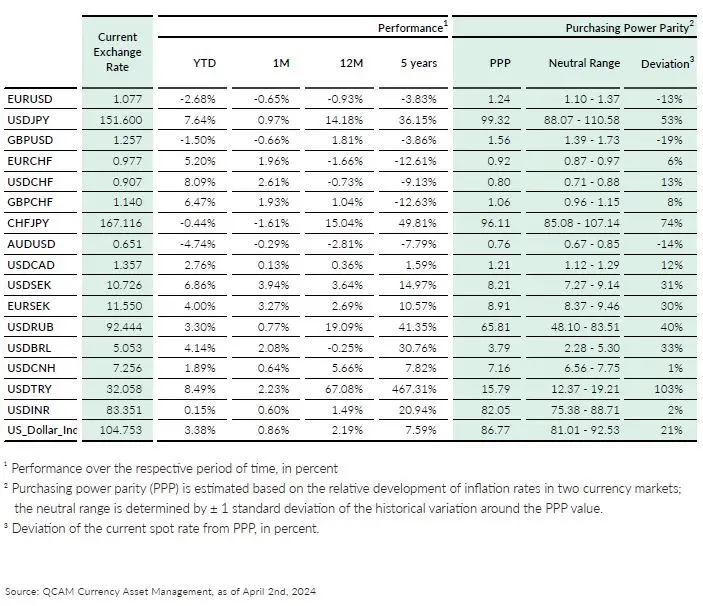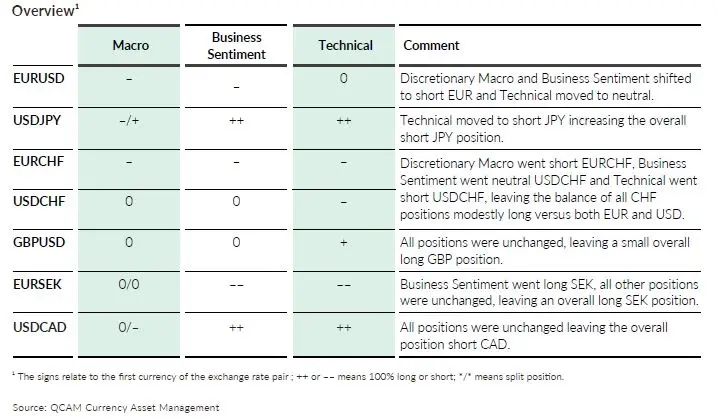The USD continued its recovery in March after a short break in February. We think the USD will on balance remain firm, but we also expect more divergence given the cross current of policy and business cycle dynamics. In particular, we think the ECB will cut interest rates earlier and more than the Fed, hurting the EUR, but we also expect that a broadening global recovery will lift commodity prices and risk sentiment, supporting currencies such as the AUD.
The USD DXY rallied nearly 1% over the last month but with a notable performance spread versus other major currencies. The USD was strongest versus the SEK and the NOK, but failed to outperform the AUD and the CAD. As outlined in prior issues of the QCAM Monthly, we see two main dynamics shaping FX markets for the rest of this year: central bank policy actions and global business cycle dynamics. On balance, we believe the USD will remain firm, but we see diverging performance patterns depending on which dynamic will dominate.
First central bank actions
The BoJ and the SNB started this year’s round of central bank actions, but in opposite directions. The BoJ finally made the long overdue first rate hike, but still disappointed market expectations, while the SNB cut rates earlier than widely expected. We think a lot more central bank action will follow from here, but timing, direction and extent is set to vary (see table).
In our view, the easing cycle will begin in Europe and not in the US. The SNB made the first move but is unlikely to be the cheer leader. The CHF has weakened significantly versus both the EUR and the USD since the start of the year. Thus, the pressure to soften the currency further has faded while the Swiss economy has not slumped like its European neighbors. We expect the SNB to cut interest rates at most for another 25 basis points. Instead, we anticipate that the ECB will take over the lead amid soft economic conditions and inflation coming close to target. Within Europe, we think the Riks Bank is most likely to shadow the ECB followed by Norges and the BoE.
Moving over to the US, rate cut expectations have been dialed back since the start of the year amid disappointing inflation and ongoing strong economic news. The Fed’s own projections still imply 75 basis points of rate cuts this year, but we think it will be at best 50 basis points. In our view, inflation will stay stubbornly close to 3% given sticky service price inflation and fading goods price deflation. The BoC will probably follow the Fed although we think that there is a chance that it will ease a bit more given pressure in the housing market.
In the Far East, we see the BoJ hiking interest rates more than expected by the market but the main outlier is probably the RBA, which we think will not move interest rates at all this year. The Australian economy is doing well yet inflation is not expected to fall consistently below 3%. As a result and given its recently tarnished credibility, we think the RBA will sit tight for longer. In contrast, we expect the RBNZ to start easing earlier amid weaker economic fundamentals, more likely disinflation progress and a tighter monetary policy stance.
More signs of global recovery
The other theme is the broadening global recovery. The JPMorgan Global Manufacturing PMI moved to 50.6 in March, up from 50.3 in February and its highest reading since July 2022. The US remains an important engine of global growth and so far continues to outperform most other major economies. Notable and important for the global economy is the recovery of business cycle conditions in China. We think China still faces significant structural problems, especially in the property sector, but the cyclical dynamic is improving thanks in part to policy stimulus. The recovery in the Euro-area remains sluggish thanks to weakness in Germany and France, but there are encouraging signs at the periphery, notably from Greece and Spain.
We think the global recovery will continue although with clear leaders and laggards and support risk sentiment and commodity prices. Besides the usual business cycle dynamics, the fading drags from high inflation are the main source for more consumption and investment in our view. From a FX perspective, the main question is whether the US economy will continue to outperform or fall in line with the trend of the rest of the world.
Mixed currency implications
On balance, we think the policy and business cycle dynamics will be positive for the USD, but not uniformly. We believe that the dynamic will be most favorable for the USD versus the EUR. We also think that the EUR should come under pressure versus the CHF as the SNB fails to ease policy as expected by the market. On the other hand, we see upside potential for currencies that benefit from the global recovery theme (risk sentiment and commodity prices) but retain a firm monetary policy stance, such as the AUD.

Source: Respective central bank websites and QCAM
Economy & Interest Rates
Global growth conditions continue to improve gradually with continued US outperformance versus the rest of the world, most notably Europe. The process of disinflation has become less even, with more progress in Europe and setbacks in the US. Soft-landing (moderate growth and lower inflation) remains the favored scenario of the market for the US as well as most of the rest of the world. However, uncertainty and the risk of a hard-landing or no-landing with an inflation rebound remain significant, leaving a range of possible monetary policy implications. In our view, most easing is likely to occur in Europe led by the ECB, while the Fed will ease less than expected and the BoJ will move interest rates gradually higher (see also article below).

FX Markets
The USD DXY rose nearly 1% over the last months. The AUD and the CAD held up well with the USD while the SEK and the NOK underperformed the most. cspeculative positions moved from neutral to slightly long USD with the GBP looking most overbought and the JPY most oversold. Short-term interest rates were mostly stable yet forwards paired back more rate-cut expectations. The cost of forward hedging versus the USD has declined but remains expensive especially for JPY and CHF. Actual and implied FX volatilities inched lower and on balance have fallen below historical levels with the notable exception of the JPY. PPP changes continue to converge as inflation moderates but differences to actual exchange rate levels remain large and the USD continues to be overvalued versus all major currencies.

FX Analytics
QCAM has developed an analytical framework to take scalable exchange rate positions. The QCAM exchange rate strategy for each currency pair has three principal components:
• Macro
• Business Sentiment
• Technical
The positioning signals from each component are aggregated into an overall positioning score for each currency pair. This score is used for the dynamic exposure management.
The Macro component consists typically of economic growth, balance of payments, fiscal and monetary policy and in some cases commodity fundamentals. The positions are either discretionary or model driven.
The Business Sentiment component is a rule-based framework built on business surveys.
The Technical component consists primarily of the technical analysis of daily exchange rates (trend following and mean reversion). We also consider speculative futures positions and the deviation of exchange rates from purchasing power parity.
The summary table below and the following pages show the QCAM strategy framework and the positioning for the major currency pairs actively covered by QCAM. The tables break each of the three strategies into subcomponents with an indication of the current impact. The charts show the respective exchange rate with past QCAM positions and their scale.
Current positioning — April 2024
The overall USD position has shifted from neutral to modestly long. On the discretionary Macro side, we went long the USD versus the EUR and we shifted long the CHF versus the EUR. Business Sentiment went short EURUSD, neutral USDCHF and short EURSEK. On balance, Business Sentiment is long USD. Technical went neutral EURUSD, long USDJPY and short USDCHF. Overall, most positions are long USD with the exception of short
USDCHF. The largest USD long positions are versus the JPY and the CAD. The EUR is short versus the CHF and the SEK.



